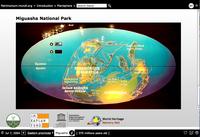You are in: North America -> Canada -> Miguasha National Park, and traditional search or Image Gallery will yield results of this site only
Miguasha National Park
| Site number: | 686 |
|
| Type of site: | Natural | |
| Date: | 370mill.yrs ago | |
| Date of Inscription: | 1999 | |
| Location: | North America, Canada, Gaspé Peninsula, Province of Quebec | |
Up to 75 images are shown here. Click on each for more details or on Image Gallery for more images.
| Description: | Regard as the world's most outstanding illustration of the Devonian Period, or the 'Age of Fishes', the palaeontological site of Miguasha National Park is located in Quebec’s south-east, sitting on Gaspé peninsula’s southern coast. The Upper Devonian Escuminac Formation represented here, dating back 370 million years, holds five of the six fossil fish groups associated with this time. The site is where the significant discovery was made of the most as well as the best-preserved fossil specimens of the lobe-finned fishes that gave rise to the tetrapods (the first four-legged, air-breathing terrestrial vertebrates). --WHMNet paraphrase from the description at WHC Site, where additional information is available. For 360 degree imaging of this site, click here. | |
| Miguasha National Park (French: Parc national Miguasha) is a protected area near Carleton-sur-Mer on the Gaspé Peninsula of Québec. Created in 1985 by the Government of Québec, Miguasha was designated a World Heritage Site in 1999 in recognition of its wealth of fossils, which display a crucial time during the evolution of life on Earth. Other names for this site are the Miguasha Fossil Site, the Bay of Escuminac Fossil Site, the Upper Devonian Escuminac Formation, and the Hugh-Miller Cliffs. --Wikipedia. Text is available under the Creative Commons Attribution-ShareAlike License. For 360 degree imaging of this site, click here. | ||
| Source: | http://whc.unesco.org/en/list/686 | |
| Reference: | 1. UNESCO World Heritage Center, Site Page. | |



















